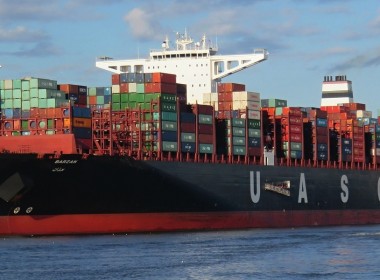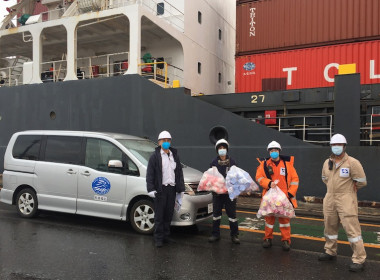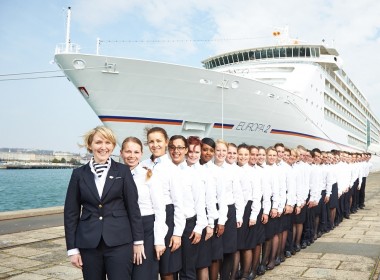COLUMN | Lash up and stow [Grey Power]

It appeared, at first glance, to be an ancient artefact, something that demanded the attention of skilled archaeologists, with their carbon dating machinery, after some farmer’s plough had brought it to the surface after aeons underground. It was, in fact a container twistlock, badly corroded and photographed by the diligent inspectors of the UK’s Marine Accident Investigation Branch. They were investigating an incident which had occurred in the North Pacific in October 2017, when the containership Ever Smart, on her eastbound passage, had lost 42 containers in heavy weather, damaging 34 others from the ship’s aftermost bay in the deck stow.
It is an interesting and rather topical report, not least because of the announcement by the Australian authorities that they are to initiate a focussed inspection regime on container security over the next months. Maybe that should not be surprising, after two incidents of container losses off their coasts, the latest of which saw a ship detained and her master charged, with deficiencies in the lashing equipment alleged.
The MAIB report is perhaps doubly welcome, because it is clear that the sea carriers are going to have to smarten up as coastal states make it clear that losses offshore will no longer be tolerated as they were once. It is no longer something that can be just written off as a consequence of “heavy weather” and more forensic and analytical procedures will follow such incidents, which will be bad both for the bottom line and the reputation of the sea carrier involved.
The MAIB have looked at the weather that was suffered by the ship, what was done to mitigate its effects, and took a close look at the ship’s lashing arrangements and the state of the containers themselves. It is a report that really needs close scrutiny by everyone involved in the carriage of containers by sea, with a great deal of useful information contained within. It might suggest that carriers need to be looking more closely at their container securing arrangements, with an eye to more regular maintenance, repair and replacement, while ensuring that once at sea, there are sufficient hands available to make sure the lashings remain tight.
There probably is no mystery about the punishment these lashings suffer when in use, both from the corrosive and salt-laden air to which they are exposed and the strains from the stacks working in a seaway. The pictures of bent and damaged turnbuckles, lashing rods and twistlocks would probably not seem that remarkable to those who work on deck on container ships and the lashing gangs in port. But while it is not exactly the ideal time to be advocating more money to be lavished on lashing equipment, it would appear such is demanded by the changing climate of opinion.
The inspectors looking at the damage aboard the Ever Smart also took the opportunity to closely examine and weigh the 107 boxes that survived the collapse of the stack, which fell over to port in what must have been an alarming fashion (although nobody witnessed it in the dark). There appeared to be quite a lot of containers that were damaged by corrosion and a number had weight variances – one over 50 per cent in excess of the declared weight. This suggests that there is still work to be done to persuade shippers of the importance of accurate weights and descriptions of cargo.
It just underlines the valuable work of the US National Cargo Bureau which, from time to time has pointed to the potential that may be found behind the innocuous doors of a steel box. Their latest study, undertaken in 2019, saw 500 loaded containers inspected at random, revealing that 44 per cent had problems with the cargo securing arrangements, 39 per cent had improper placarding, while eight per cent was discovered to have misdeclared cargo.
I suppose we really ought to discover whether this is worse, or better, than the situation in previous NCB surveys, which I recall showed up some real horrors, both in terms of misdeclared weights and undeclared hazardous cargo. You would like to think that mandatory requirements are beginning to make a difference. People who run container ships, urged to minimise port time and having to take on trust what others tell them are contained in the huge numbers of boxes exchanged, perhaps need to be given a bit more confidence. And if the scrutiny of the authorities is to be enhanced, maybe that is not a bad thing all round.
Curiously there still does not seem to be any real consensus about the optimum height of container guides above the deck. I was looking at a picture of a new OOCL ship which had the “racks” extending six boxes high, which would seem to be a lot safer than relying on so much portable lashing. Stevedores, however, express reservations about the time lost in digging into the stack when these have to be circumvented. What do I know?
And while one should be cautious injecting a personal note into this topic, my next door neighbour tells me that last week he was opening a 40-footer with the shipment of electric vehicles he had been eagerly awaiting for some weeks. There were three of these in the box, all, to his chagrin, with squashed bumpers, because nobody, on the other side of the world, had seen fit to lash them in place.







